seats INFINITI QX56 2009 Factory Owner's Manual
[x] Cancel search | Manufacturer: INFINITI, Model Year: 2009, Model line: QX56, Model: INFINITI QX56 2009Pages: 4171, PDF Size: 84.65 MB
Page 3189 of 4171

SEAT BELTSSB-11
< ON-VEHICLE REPAIR >
C
DE
F
G
I
J
K L
M A
B
SB
N
O P
4. Remove push pin (2) and release elastic ban (3) from seat frame (1). Repeat for opposite seat.
•⇐ : Vehicle front
5. Partially lift seatback upright, then remove seat belt buckle (2) from between hinge cover (1) and seat cushion side facing (3).
Repeat for LH seat.
•⇐ : Vehicle front
Installation
Installation is in the reverse order of removal.
• Raise and lock both seats in the full upright position to check for abnormal noises or binding.
Seat Belt InspectionINFOID:0000000003775150
AFTER A COLLISION
WARNING:
Inspect all seat belt assemblies including retractors and attaching hardware after any collision.
NISSAN recommends that all seat belt assemblies in u se during a collision be replaced unless the col-
lision was minor and the belts show no damage and continue to operate properly. Failure to do so
could result in serious personal injury in an accide nt. Seat belt assemblies not in use during a colli-
sion should also be replaced if either damage or im proper operation is noted. Seat belt pre-tensioners
should be replaced even if the seat belts are not in use during a frontal collision in which the air bags
are deployed.
Replace any seat belt retractor and belt assembly (including anchor bolts) if:
• The seat belt was in use at the time of a collision (except for minor collisions and the belts, retractors and buckles show no damage and continue to operate properly).
• The seat belt was damaged in an accident. (i.e. torn webbing, bent retractor or guide).
• The seat belt attaching point was damaged in an accident. Inspect the seat belt attaching area for damage
or distortion and repair as necessary before installing a new seat belt retractor and belt assembly.
• Anchor bolts are deformed or worn out.
• The seat belt pre-tensioner should be replaced even if t he seat belts are not in use during the collision in
which the air bags are deployed.
PRELIMINARY CHECKS
1. Check the seat belt warning lamp/chime for proper operation as follows:
a. Switch ignition ON. The seat belt warning lamp should illuminate. Also, the seat belt warning chime should sound for about seven seconds.
b. Fasten drivers seat belt. The seat belt warning lamp should go out and the chime (if sounding) should stop.
2. If the air bag warning lamp is blinking, conduct self-diagnosis using CONSULT-III, and air bag warning
lamp. Refer to SRC-13, "
SRS Operation Check".
3. Check that the seat belt retractor and belt asse mbly, seat belt anchor and buckle bolts are securely
attached.
LHIA0105E
LHIA0106E
Revision: December 20092009 QX56
Page 3190 of 4171
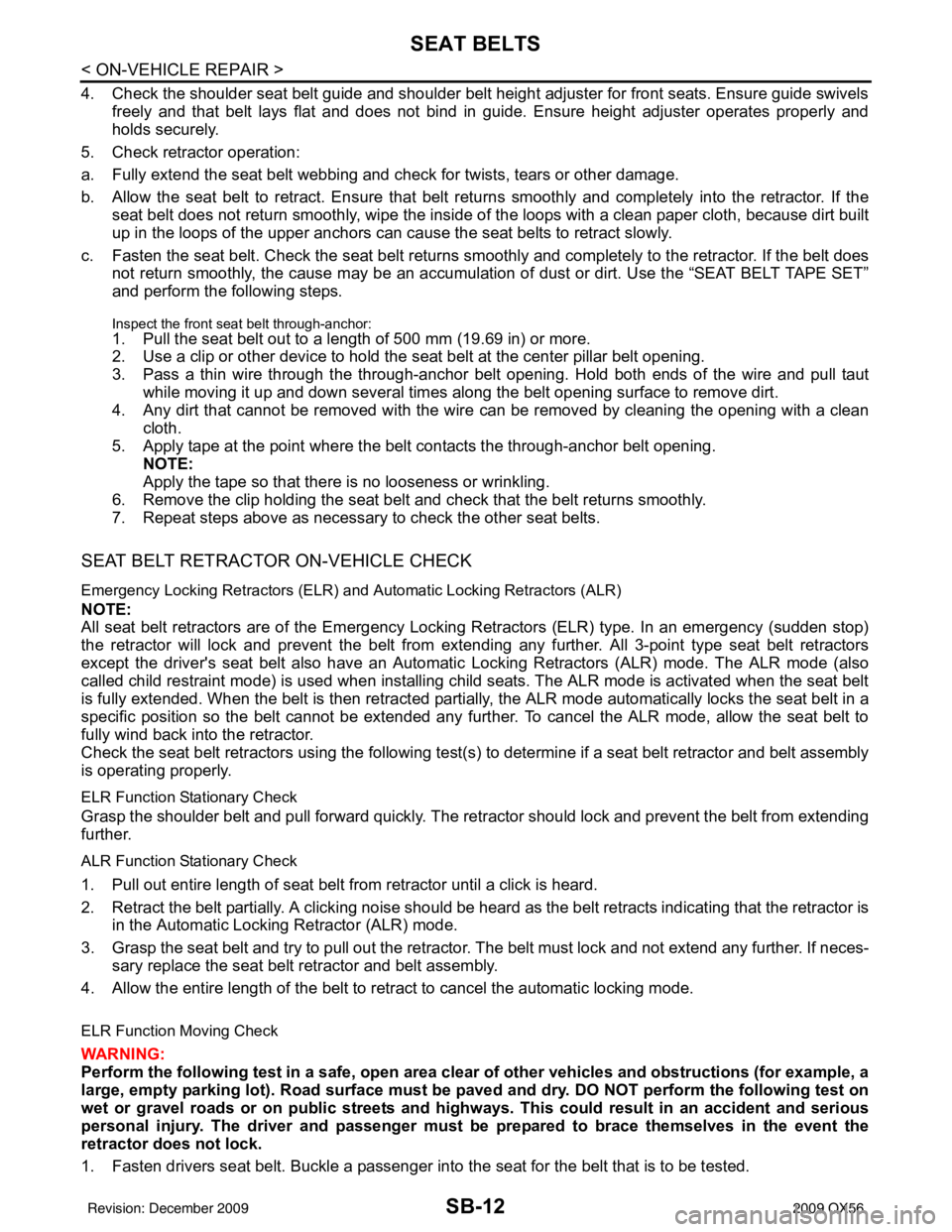
SB-12
< ON-VEHICLE REPAIR >
SEAT BELTS
4. Check the shoulder seat belt guide and shoulder belt height adjuster for\
front seats. Ensure guide swivelsfreely and that belt lays flat and does not bind in guide. Ensure height adjuster operates properly and
holds securely.
5. Check retractor operation:
a. Fully extend the seat belt webbing and check for twists, tears or other damage.
b. Allow the seat belt to retract. Ensure that belt retu rns smoothly and completely into the retractor. If the
seat belt does not return smoothly, wipe the inside of the loops with a clean paper cloth, because dirt built
up in the loops of the upper anchors can c ause the seat belts to retract slowly.
c. Fasten the seat belt. Check the seat belt returns smoothly and completely to the retractor. If the belt does not return smoothly, the cause may be an accumulati on of dust or dirt. Use the “SEAT BELT TAPE SET”
and perform the following steps.
Inspect the front seat belt through-anchor:1. Pull the seat belt out to a length of 500 mm (19.69 in) or more.
2. Use a clip or other device to hold the seat belt at the center pillar belt opening.
3. Pass a thin wire through the through-anchor belt opening. Hold both ends of the wire and pull taut while moving it up and down several times along the belt opening surface to remove dirt.
4. Any dirt that cannot be removed with the wir e can be removed by cleaning the opening with a clean
cloth.
5. Apply tape at the point where the belt contacts the through-anchor belt opening.
NOTE:
Apply the tape so that there is no looseness or wrinkling.
6. Remove the clip holding the seat belt and check that the belt returns smoothly.
7. Repeat steps above as necessary to check the other seat belts.
SEAT BELT RETRACTOR ON-VEHICLE CHECK
Emergency Locking Retractors (ELR) and Automatic Locking Retractors (ALR)
NOTE:
All seat belt retractors are of the Emergency Locking Retractors (ELR) type. In an emergency (sudden stop)
the retractor will lock and prevent the belt from ext ending any further. All 3-point type seat belt retractors
except the driver's seat belt also have an Automati c Locking Retractors (ALR) mode. The ALR mode (also
called child restraint mode) is used when installing child seats. The ALR mode is activated when the seat belt
is fully extended. When the belt is then retracted partiall y, the ALR mode automatically locks the seat belt in a
specific position so the belt cannot be extended any furt her. To cancel the ALR mode, allow the seat belt to
fully wind back into the retractor.
Check the seat belt retractors using the following test(s ) to determine if a seat belt retractor and belt assembly
is operating properly.
ELR Function Stationary Check
Grasp the shoulder belt and pull forward quickly. The re tractor should lock and prevent the belt from extending
further.
ALR Function Stationary Check
1. Pull out entire length of seat belt from retractor until a click is heard.
2. Retract the belt partially. A clicking noise should be hear d as the belt retracts indicating that the retractor is
in the Automatic Locking Retractor (ALR) mode.
3. Grasp the seat belt and try to pull out the retractor. The belt must lock and not extend any further. If neces-
sary replace the seat belt retractor and belt assembly.
4. Allow the entire length of the belt to re tract to cancel the automatic locking mode.
ELR Function Moving Check
WARNING:
Perform the following test in a safe, open area clear of other vehicles and obstructions (for example, a
large, empty parking lot). Road surface must be p aved and dry. DO NOT perform the following test on
wet or gravel roads or on public streets and highw ays. This could result in an accident and serious
personal injury. The driver and passenger must be prepared to brace themselves in the event the
retractor does not lock.
1. Fasten drivers seat belt. Buckle a passenger in to the seat for the belt that is to be tested.
Revision: December 20092009 QX56
Page 3233 of 4171

SE-1
BODY INTERIOR
C
DE
F
G H
I
K L
M
SECTION SE
A
B
SE
N
O P
CONTENTS
SEAT
BASIC INSPECTION ....... .............................3
DIAGNOSIS AND REPAIR WORKFLOW ..... .....3
Work Flow ........................................................... ......3
INSPECTION AND ADJUSTMENT .....................5
Preliminary Check ............................................... ......5
FUNCTION DIAGNOSIS ...............................6
THIRD ROW POWER FOLDING SEAT ......... .....6
System Description ............................................. ......6
Component Parts Location ........................................7
Component Description .............................................7
COMPONENT DIAGNOSIS ..........................8
POWER SEAT .....................................................8
Wiring Diagram — Passenger Side — ................ ......8
HEATED SEAT ...................................................12
Description ..............................................................12
Wiring Diagram .......................................................13
THIRD SEAT ......................................................19
Power Supply and Ground Circuit Check for Third
Row Power Folding Seat Control Unit ................. ....
19
Third Row Power Folding Seat Switch ....................20
Third Row Power Folding Seat Motor .....................20
ECU DIAGNOSIS .........................................22
THIRD ROW POWER FOLDING SEAT CON-
TROL UNIT .........................................................
22
Reference Value ................................................. ....22
Wiring Diagram .......................................................24
DTC Index ...............................................................29
Fail Safe ..................................................................30
SYMPTOM DIAGNOSIS ..............................31
THIRD ROW POWER FOLDING SEAT ......... ....31
Symptom Table ................................................... ....31
NONE OF THE THIRD ROW POWER FOLD-
ING SEATS WILL OPERATE WITH ANY
SWITCH. ............................................................
32
None of the Third Row Power Folding Seats Will
Operate With Any Third Row Power Folding Seat
Switch .................................................................. ....
32
ONLY ONE THIRD ROW POWER FOLDING
SEAT WILL OPERATE. ....................................
33
Only One Third Row Power Folding Seat Will Op-
erate .................................................................... ....
33
THIRD ROW POWER FOLDING SEAT WILL
OPERATE IN ONLY ONE DIRECTION. ...........
35
Third Row Power Folding Seat Will Operate in
Only One Direction .............................................. ....
35
THIRD ROW POWER FOLDING SEAT WILL
STOP SHORT OF IT’S FULLY UP OR DOWN
POSITION. .........................................................
36
Third Row Power Folding Seat Stops Short of it's
Fully Up or Down Position .......................................
36
THIRD ROW POWER FOLDING SEAT
MAKES EXCESSIVE NOISE WHILE MOV-
ING. ...................................................................
37
Third Row Power Folding Seat Makes Excessive
Noise While Moving ............................................. ....
37
SQUEAK AND RATTLE TROUBLE DIAG-
NOSES ..............................................................
38
Work Flow ................................................................38
Generic Squeak and Rattle Troubleshooting ...........40
Diagnostic Worksheet ..............................................42
PRECAUTION ..............................................44
PRECAUTIONS .................................................44
Precaution for Supplemental Restraint System
(SRS) "AIR BAG" and "SEAT BELT PRE-TEN-
SIONER" ............................................................. ....
44
Revision: December 20092009 QX56
Page 3237 of 4171

INSPECTION AND ADJUSTMENTSE-5
< BASIC INSPECTION >
C
DE
F
G H
I
K L
M A
B
SE
N
O P
INSPECTION AND ADJUSTMENT
Preliminary CheckINFOID:0000000003775440
1.FOREIGN OBJECTS
Check the following:
• objects on or behind the seats that could cause binding
• objects under the seats that may be in terfering with the seat’s moving parts
Are there any foreign objects that could be causing interference with the seats?
YES >> Remove objects.
NO >> GO TO 2.
2.WIRING CONNECTIONS
1. Disconnect third row power folding seat c ontrol unit and seat motor harness connectors.
2. Check terminals for damage or loose connections.
3. Reconnect harness connectors.
Are any connectors damaged or loose?
YES >> Repair or replace damaged parts.
NO >> GO TO 3.
3.POWER AND GROUND
Check power supply and ground circuits for third row power folding seat control unit. Refer to SE-19, "
Power
Supply and Ground Circuit Check for Third Row Power Folding Seat Control Unit".
Is the inspection result normal?
YES >> Refer to SE-29, "DTC Index".
NO >> Repair or replace as necessary.
Revision: December 20092009 QX56
Page 3239 of 4171

THIRD ROW POWER FOLDING SEATSE-7
< FUNCTION DIAGNOSIS >
C
DE
F
G H
I
K L
M A
B
SE
N
O P
Component Parts LocationINFOID:0000000003775442
Component DescriptionINFOID:0000000003775443
ALJIA0088ZZ
1. Third row power folding seat control unit B401, B402 2. A/T assembly F9 3. Third row power folding seat switches
A: Third row power folding seat sw itch passenger side (front) B162
B: Third row power folding seat switch driver side (front) B164
C: Third row power folding seat switch passenger side (rear) B163
D: Third row power folding seat switch driver side (rear) B165
4. Third row power folding seat motors
A: RH (40%) seat B426
B: LH (60%) seat B403
Component Function
Third row power folding seat control unit • Receive inputs from third row power folding seat switches and A/T assembly (PNP
switch)
• Drive third row powe r folding seat motors
• Performs self-diagnostics
A/T assembly Provide PNP switch signal to third row power folding seat control unit
Third row power folding seat switches Provide fold up/fold down ground signals to third row power folding seat control unit
Third row power folding seat motors • Fold seats up and down
• Provide feedback signals to third row power folding seat control unit
Revision: December 20092009 QX56
Page 3241 of 4171
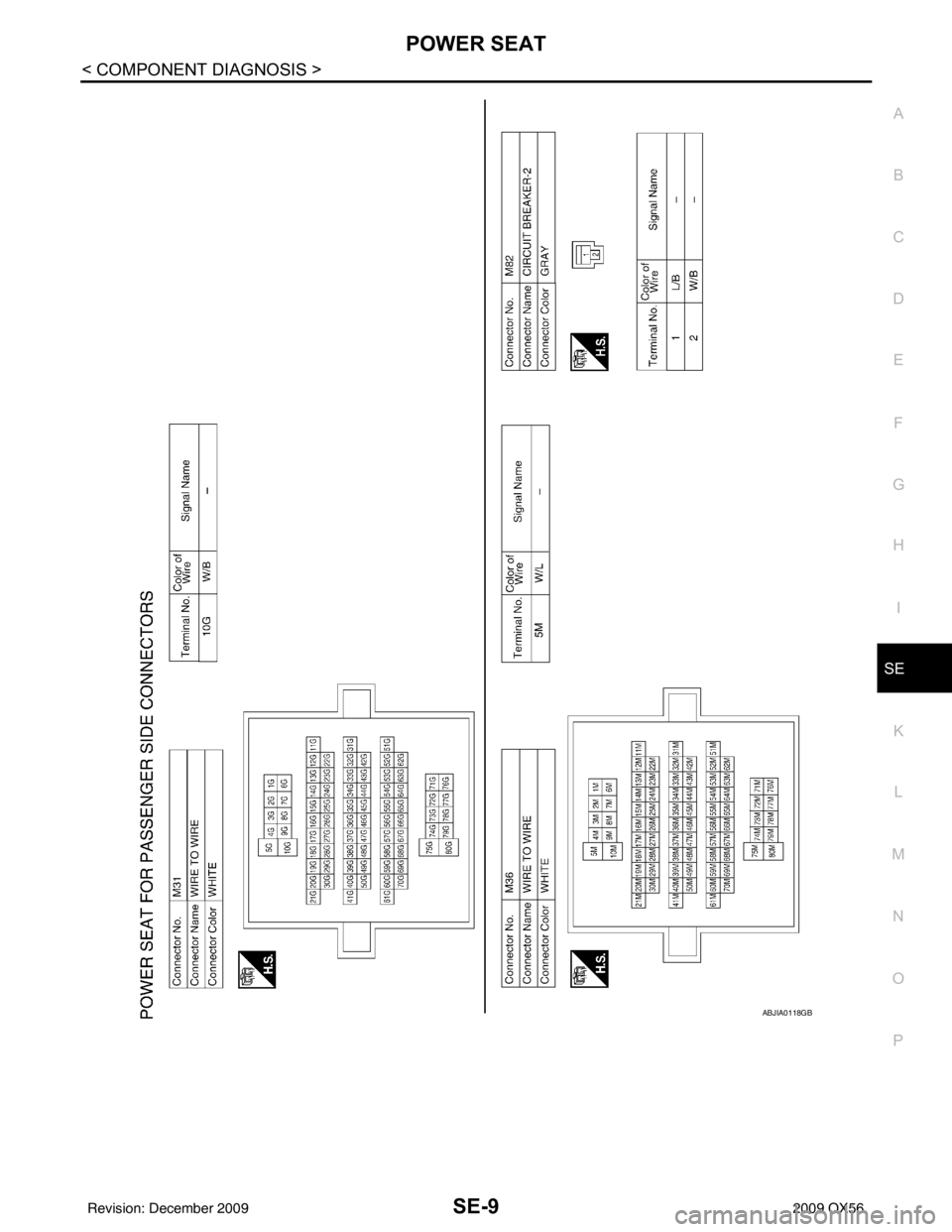
POWER SEATSE-9
< COMPONENT DIAGNOSIS >
C
DE
F
G H
I
K L
M A
B
SE
N
O P
ABJIA0118GB
Revision: December 20092009 QX56
Page 3243 of 4171
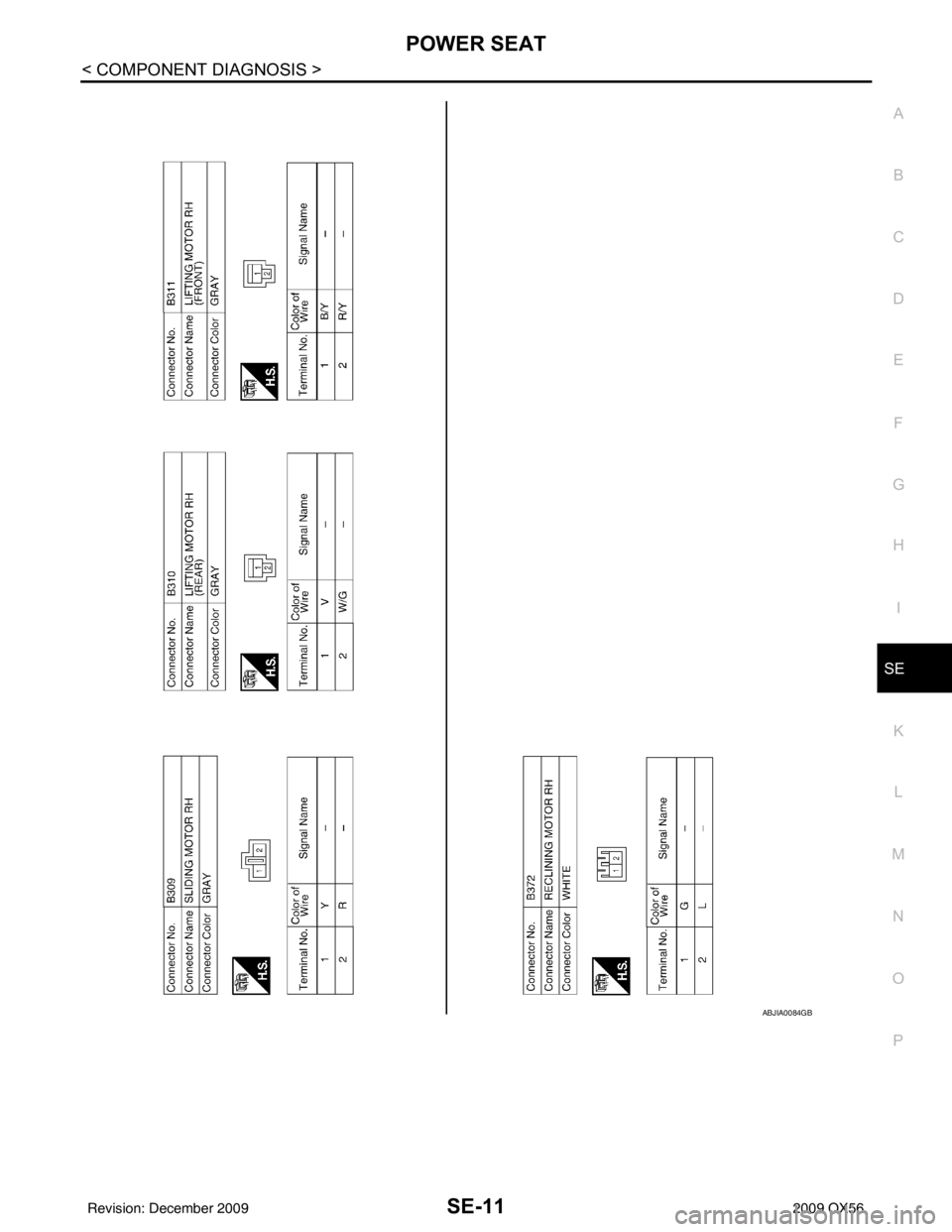
POWER SEATSE-11
< COMPONENT DIAGNOSIS >
C
DE
F
G H
I
K L
M A
B
SE
N
O P
ABJIA0084GB
Revision: December 20092009 QX56
Page 3245 of 4171

HEATED SEATSE-13
< COMPONENT DIAGNOSIS >
C
DE
F
G H
I
K L
M A
B
SE
N
O P
Wiring DiagramINFOID:0000000003775446
ABJWA0031GB
Revision: December 20092009 QX56
Page 3247 of 4171
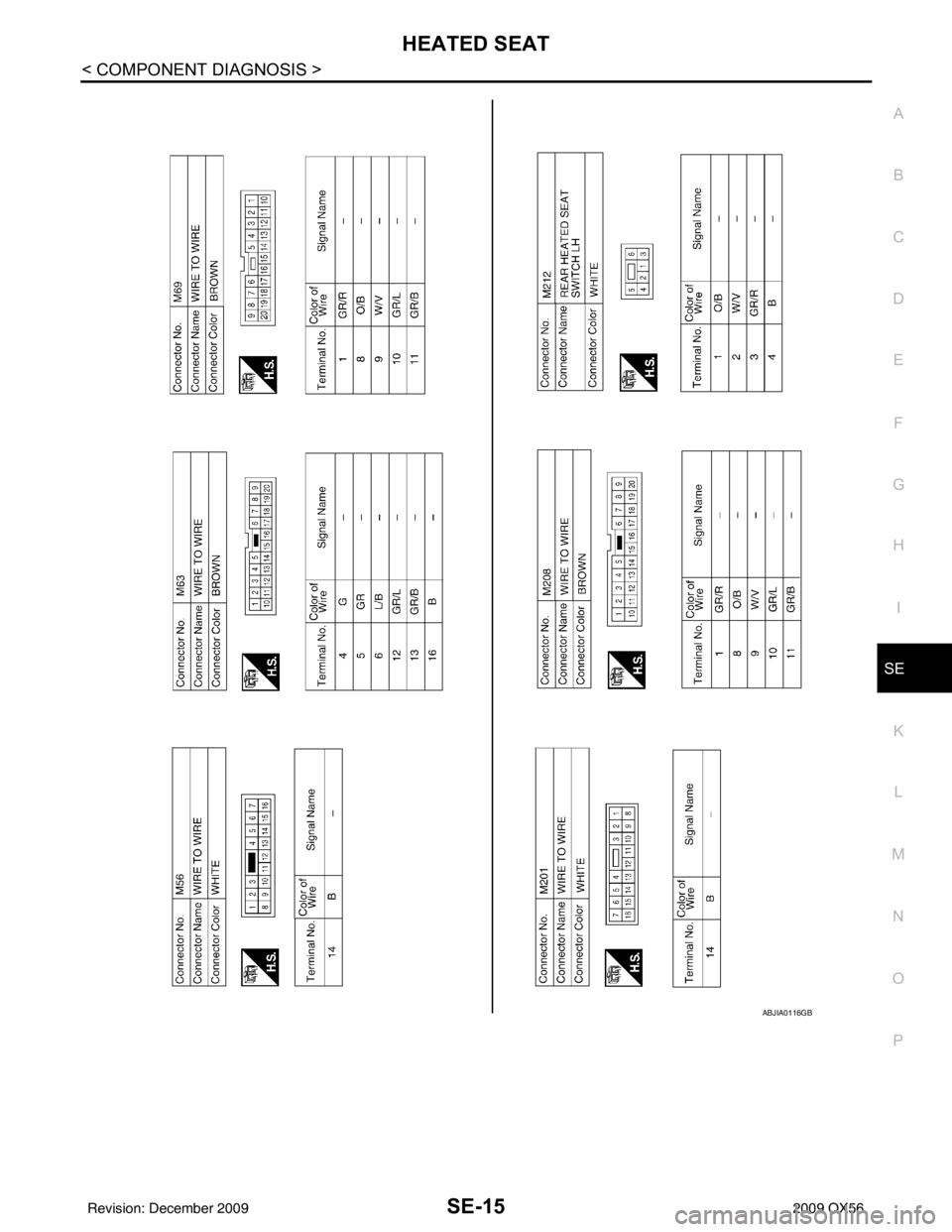
HEATED SEATSE-15
< COMPONENT DIAGNOSIS >
C
DE
F
G H
I
K L
M A
B
SE
N
O P
ABJIA0116GB
Revision: December 20092009 QX56
Page 3249 of 4171
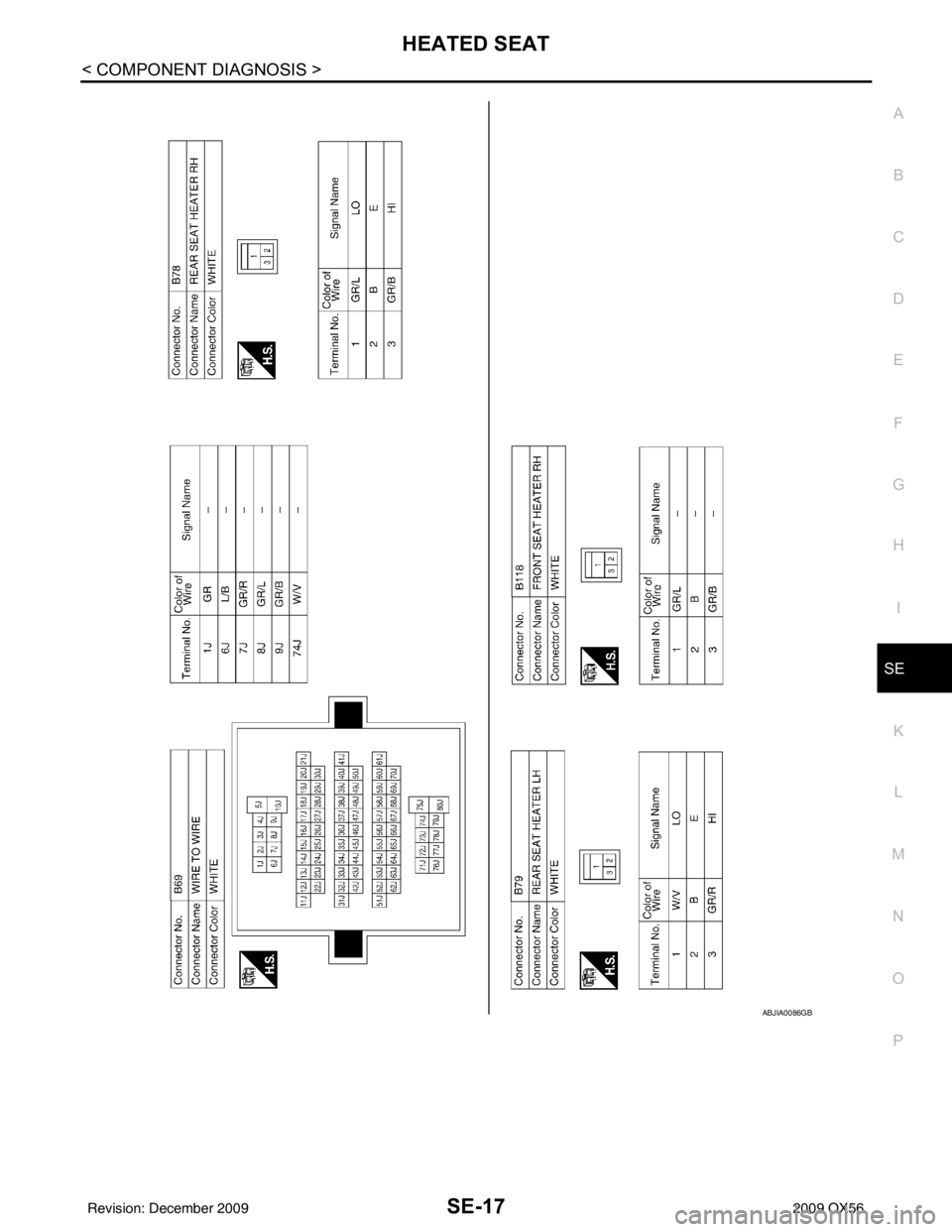
HEATED SEATSE-17
< COMPONENT DIAGNOSIS >
C
DE
F
G H
I
K L
M A
B
SE
N
O P
ABJIA0086GB
Revision: December 20092009 QX56